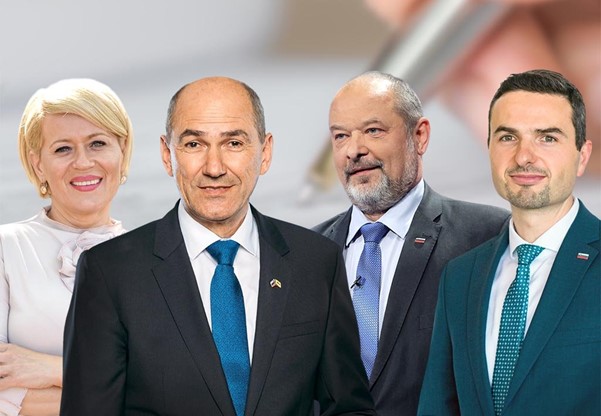By: Domen Mezeg
According to the latest public opinion poll, the Slovenian Democratic Party (Slovenska demokratska stranka – SDS), New Slovenia Party (NSi), Let’s Connect Slovenia party (Povežimo Slovenijo), and Our Country party (Naša dežela) would be able to form a new coalition. In total, they would receive 46.4 percent of the votes, while the so-called Constitutional Arch Coalition (the left-wing parties of the current opposition) and the party of the new face of the left, Golob, would only receive 42.8 percent. At the same time, it is clear that the List of Marjan Šarec (LMŠ) would not get into parliament.
The results of the public opinion poll conducted for our media outlet, Nova24TV, by the Parsifal Agency between the 31st of March and the 4th of April 2022, show that, according to the responses of the voters who already know who they would vote for, eight parties would get into parliament. In terms of those who already know who they would vote for, the parties would receive the following percentage of votes: SDS (31.3 %), the Freedom Movement – Gibanje svoboda (22.1 %), the Social Democrats – Socialni demokrati (SD) (10 %), NSi (6.4 %), the Left party – Levica (6.4 %), Let’s Connect Slovenia (4.7 %), the Party of Alenka Bratušek (SAB) (4.3 %), and Our Country (4 %).
The following parties would not get into parliament: the List of Marjan Šarec – Lista Marjana Šarca (LMŠ) (2.4 %), the Democratic Party of Pensioners of Slovenia – Demokratična stranka upokojencev Slovenije (DeSUS) (2.4 %), the Truth party – Resni.ca (1.7 %), Slovenian National Party – Slovenska nacionalna stranka (SNS) (1.3 %), Vesna (1.2 %), Pirates – Pirati (1.0%), Our Future – Naša prihodnost (0.8 %) and other smaller parties.
It is clear that this time, the elections will be decided by smaller parties, and according to the latest public opinion poll, the LMŠ party will likely leave the parliament, thus reducing the chances of a formation of a left-wing government. The SAB party is additionally threatened by the Our Country party, led by Aleksandra Pivec, who is also betting on pensioners, after it became clear some time ago that they can no longer count on the DeSUS party. However, Our Country party also has an advantage due to the strong emphasis they have put on content, as well as the great determination of President Pivec to get into parliament. We would also like to remind our readers of the fact that Pivec has been the victim of the political discrediting of Martin Odlazek‘s garbage media and her political competition for quite some time now because she represents a party that will be the deciding factor in the formation of the government.
The voters will award cooperation and willingness to connect
The programme is also a weak point of the SAB and LMŠ parties. It will be increasingly difficult to convince voters with phantom anti-Janšaistic claims. It seems that the voters have finally had enough of the exclusivity embodied by the Constitutional Arch Coalition parties and the Freedom Movement. The opposite of that is the Let’s Connect Slovenia movement, which brings together different parties and is proof that integration in the political environment is possible and also something that the voters want. The latter is also the only serious possibility for the future of the Slovenian political space.
Demographic data
The survey included 800 participants, of which 50.9 % were women. The average age of the participants is 55.1 years, and the standard deviation is 16.3 years. The majority of the respondents are from the oldest age group (50.2 %), a slightly smaller share of participants belongs to the middle age group (13.7 %), and the smallest number of respondents is from the youngest age group (13.7 %). The majority of the respondents have completed high school (31. 9 %), followed by those with completed high education or higher (28. 5 %), 22.3 % of respondents have finished vocational school, and 17.2 % have either completed or have not completed primary school. The majority of the respondents currently reside in a small village or hamlet (55.5 %), followed by those who live in the city (29.1 %) or a smaller town (15.4 %). Most of the respondents are from Central Slovenia (25.4 %), followed by the Podravska (15.6 %) and Savinjska (12.8 %) regions.
